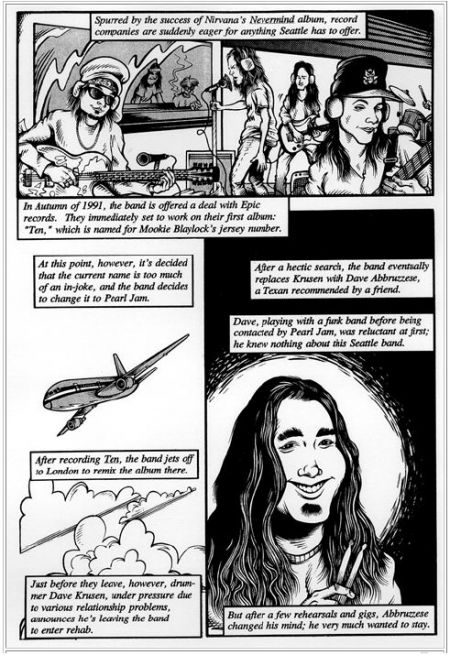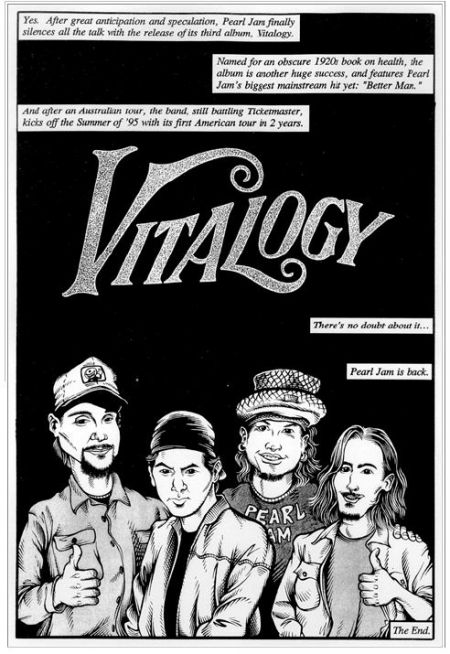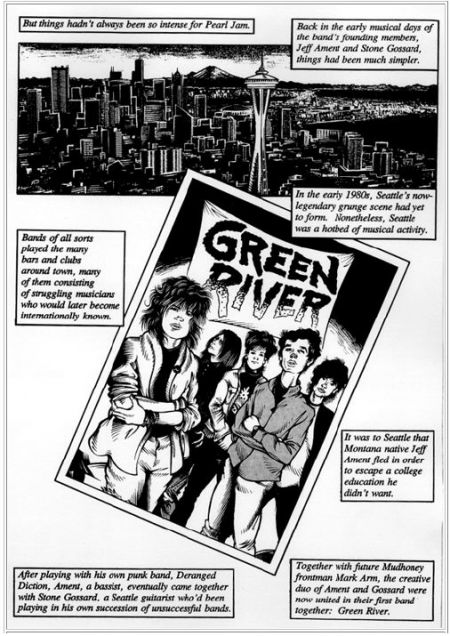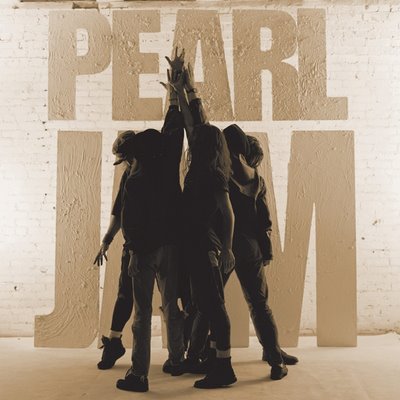Grunge Comics Presents #2: The Pearl Jam Story
By Andy Frisk
April 19, 2009 - 19:13
First Amendment Publishing
Writer(s): Jerry Kenney
Penciller(s): Jared Phillips
$3.00 US (original cover price)
Pearl Jam’s first album, Ten is considered one of the most influential albums of the entire “alt-rock” movement of the early 1990’s, from which the band and the album sprung, and which is now looked back on by us GenX'ers with fond memories of the days of flannel shirts, khaki cut off shorts, and Doc Martens under the sun at the, once mobile, Lollapalooza summer concerts. Flannel shirts, khaki cut offs and Doc Martens in the hot sun! What were we thinking?! Well…dressing like each other, and our rock n’ roll heroes, was how we, um...asserted our individuality. Well, whatever…nevermind. The poor choices in the style of dress notwithstanding, the music of the early to mid 1990’s is truly some of the most passionate and engaging music ever produced, Pearl Jam, in my humble opinion, was the best of the bands that came out of the grunge movement, and have proven to be the most long lasting. In the years following the release of Ten in 1991, Pearl Jam dominated the music scene, and were everywhere one looked at one point, except for MTV heavy rotation since they didn’t make videos. The one proper video from Ten, for the song “Jeremy,” was pretty much the only video fans would get for several years. It was only a matter of time before someone produced a comic book about them, and this happened when First Amendment Publishing released the second issue of Grunge Comics Presents subtitled The Pearl Jam Story.

In full wail.
This all black and white biography of the band was one of the most unique items of Pearl Jam memorabilia I could have gotten my hands on at the time. I mean, here was the product of two of my favorite art forms crossing over: music and comics. I remembering coming across this gem at my local comic shop, and almost flipping out. I readily plunked down the, at the time, pretty outrageous cover price of $3.00 for a black and white, pretty low quality paper, comic book. I was glad I did it though, at the time, and now 15 years later, I’m even more grateful. This comic is truly a nostalgic snapshot of its time period, from its inaccuracies about the band, believed to be true at the time, to its accuracies, and its earnestness. It serves as an historical piece that captures the time period it covers, and unintentionally, the grab for cash that quickly ensued by anyone and everyone who could capitalize on this new rock revolution, and its fans. I’m happy to say though that The Pearl Jam Story's author, Jerry Kenney, does attempt to produce an interesting, and as accurate as possible, with the exception of an over emphasis on Pearl Jam’s lead singer Eddie Vedder’s “angst,” graphic novelization of the band’s early years.

Pearl Jam finds a drummer.
The story begins with a rendering of the Pearl Jam concert in

Thumbs up, except for Eddie that ansty young man!
Phillips' art is quite good, and he catches the physicality of the band’s highly energetic shows of the period, but its his depictions and recreations of the band’s facial features which stands out the most. He accurately captures their likenesses. When he draws Eddie Vedder, he is recognizable as Eddie Vedder, but Vedder and the rest of the band all have the look of caricature drawings that one might see on the wall of a famous restaurant, or that can be done at amusements parks. They don’t by any means look silly; they just have the look of a caricature. This, perhaps intentionally, draws attention to the fact that the story itself, while pretty accurate in its depiction of events, is (like all biographies are to a certain extent) a caricature of the individuals it is depicting. For example Vedder is depicted as “living in a shack” on the beach in San Diego, later revealed to be a modest apartment in real life, and the depiction of him singing into a microphone with headphones on, his face contorted into an angst ridden wail as he creates the vocals for his demo for Gossard and Ament, can really only be a caricature of an event that no one witnessed. This event was not in any way visually recorded so the only way to render it is through a recreation of a facial expression displayed by Vedder while he performed at one of Pearl Jam’s public concerts. It’s a necessary fabrication that is understandable, but proves itself to be a caricature of this defining moment in Vedder’s and Pearl Jam’s history. Taking a step back theoretically, and looking at the entire graphic novelization of the Pearl Jam story, it makes sense that nearly all the events of the work must, by nature, be a caricature of the actual events.

One of Ament's and Gossard's pre-Pearl Jam, Seattle based bands, Green River
Herein is where the comic becomes something more than just a cute little fan friendly doodle of a great band. It is a type of comics journalism that captures the spirit of the music industry, and the perceived spirit of its fans at the time of its publication. By being a caricature of actual events, but with nearly every single shot of our tale’s hero, Vedder, being the picture of an angst ridden borderline mental breakdown, disaffected youth, we only get one side of his personality, and quite possibly constructed public persona. I do not doubt that Vedder was the angsty young GenX'er dealing with the harsh realities of new found stardom, but Phillips’ renderings of him really drive home the point and portray him as being nothing else at all. The prevailing spirit in music, and rock journalism, which this comic is an example of, at the time, focused solely upon the “horrible” angst and disaffection that grunge and bands like Pearl Jam were supposed to champion with their music. They all failed, though, to capture the spirit of enlightenment and new beginning that the movement also represented to many of us GenX'ers. Yes, Vedder and Pearl Jam were angry, but they challenged us to get up and do something about our situations, be them issues with parents, or the desire to do something positive for the less fortunate, or even the environment. Remember in “Jeremy,” perhaps Ten's biggest hit, the story Vedder told about a neglected and outcast child who commits suicide (based on an actual event), wasn’t a glorification of this act or a celebration of giving up. It was a plea to not make the same mistake of acting the way Vedder does in the song (he is a bully who “remembers picking on the boy”), and to take compassion on your fellow classmates, peers, co-workers and mankind. A little more focus on the positives of the music, and/or reasons behind Vedder’s angst (they do mention the issue of his not knowing his real father, the subject of “Alive”), instead of just an in your face anger at the world rendering of Vedder and Co, would made this work recognized more for its artistry, in oposition to, its reportage.
There is some humor in the work though. There’s a little tale tacked on after the Pearl Jam bio about a sorry group of GenX grungers who try to win some money off a radio show, but what really composes the bulk of the humor in the issue is the unintentionally, and with hindsight, really funny interlude by the publisher in the middle of the book. There's a “Grunge News” column, where snippets of news on Greenday’s (not Green Day’s) new upcoming album are listed as well as a column titled “Love Notes,” which follows Courtney Love’s then current troubles (as if she’d even be relevant in a few months), and perhaps the funniest of all, a column titled “some TRUE FACTS about the band…” where the now debunked, by Vedder himself, myth that the name Pearl Jam is a reference to his grandmother’s homemade jam that had peyote mixed in as an ingredient. This falsehood, believed to be true at the time of publication, alone makes this work a treasure of a nostalgic piece of history.

Cover art for Ten (Redux)
Overall, Grunge Comics Presents: The Pearl Jam Story is a fascinating piece of comic book and music history which captures the public view of Pearl Jam, their music, and the inevitable rush by business to cash in on its fans expendable income, prevalent in the years following the “grunge revolution.” To me, it will always be a memento of a time when I felt, even though this comic doesn’t quite convey it, a great youthful optimism about the future, mostly because for millions of us GenX’ers we found, whether he liked it or not, a voice for a generation in Eddie Vedder who acknowledged that, yeah life sucks sometimes, but it can be changed for the better.
Rating: 10/10
Related Articles:
Che: A Graphic Biography
Animation pioneer Lou Scheimer autobiography out September 26
Rama IX - King of Thailand - A Comic Book Biography Volume 3
Ayn Rand's “Female Force “ comic book biography ” in stores june 22nd
Stephen King's new comic book biography in stores june 22nd.
Green Lantern's Ryan Reynolds powers own comic book biography in stores now
Steve Jobs Biography Comic Coming in August from Bluewater
Donald Trump’s larger than life persona carries a new biography comic
Lindsay Lohan’s wild life captured in new biography comic book
Ayn Rand’s enduring impact centerpiece of new female force biography comic
